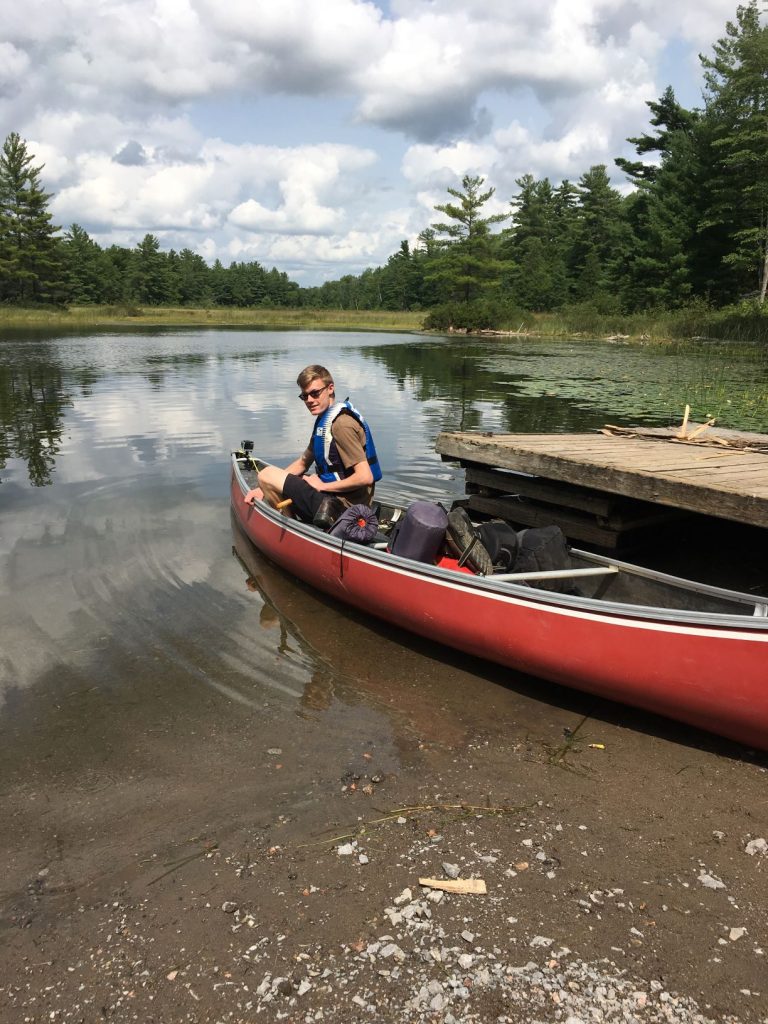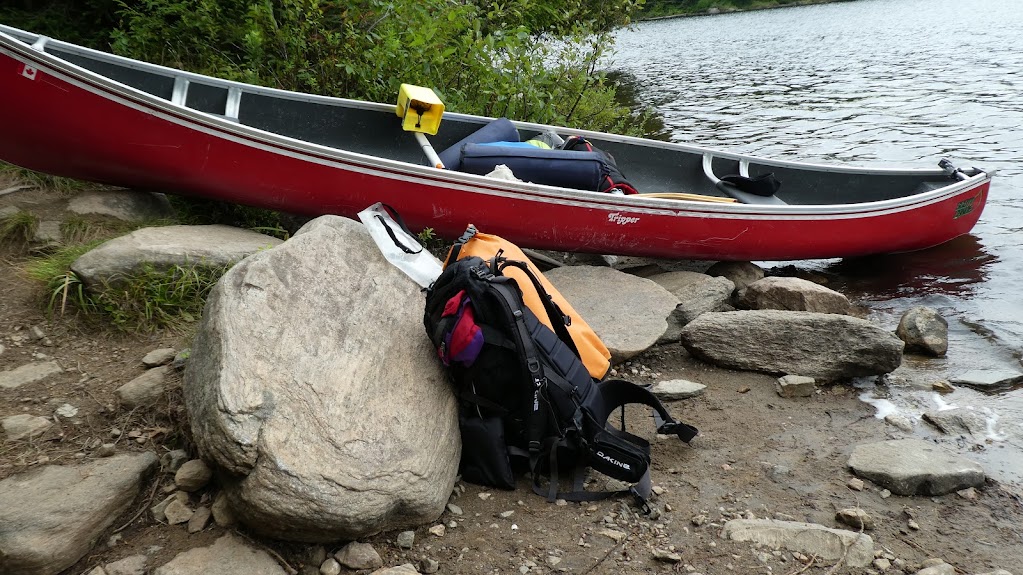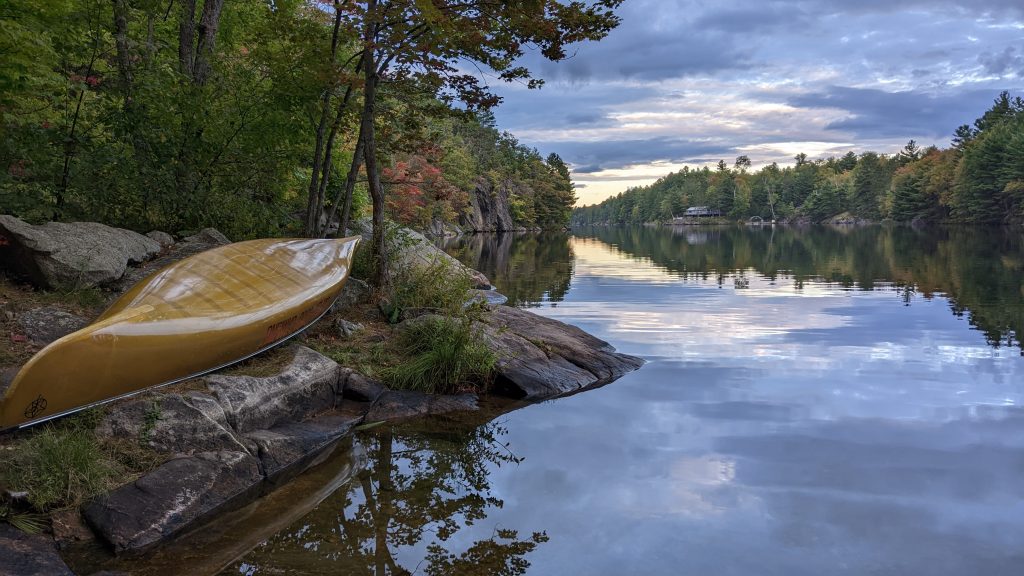
Below is the transcript from our podcast episode on Canoes, enjoy!
Pamela:
Hello and Good day, eh. Welcome to the Super Good Camping podcast. My name is Pamela
Tim:
and I’m Tim
Pamela:
and we are on a mission to inspire other families to enjoy camping adventures such as we have with our kids.
Today we have a one-topic episode that is going to be about canoes, and we’re recording this at the halftime of the football game. If you’ve missed hearing our voices, that would be because football has started. Anyways, Tim is here because he’s not away camping this weekend, which is where he was supposed to be. He should be backcountry camping at Kawartha Highlands but because of inclement weather, that trip got canceled, unfortunately!
Tim:
For the first time ever, which makes me very sad, but I’m not going to talk about that, because I’m still pining.
So this episode started out that I wanted to talk about different types of canoes, but doing a bunch of research I also discovered that the different types of canoes also had a very sort of evolutionary lean to them. So I’m just gonna jump into it.
Historic canoes, certainly here in Canada Indigenous/First Nation people made canoes out of…. I suspect the first one was just wrapping their arms around a trunk of a tree that was floating down the river. But then at some point, somebody figured out carving out the inside. I can’t say it was just here, as much as I think canoeing is a Canadian thing. It apparently shows up all over the place including Sweden and Nigeria.
So then they went into dugouts which is a nice version of a wooden canoe. That’s a lot of work to chisel all that wood out. So you’ve got only a third of a trunk of a tree to float down the river. Eventually, they worked their way towards making a frame, sometimes out of wood, and then lashing together steamed and bent poles, or whale bones, or other large animal bones. Again, we take a rib bone from a whale – that’s big and it curves. Then they strap skins over. It’s usually waterproof-type skins, meaning seals, walruses, that sort of deal. But I’ve also read stories about them using caribou and then from seal hunting, taking the oil from the seal and using it to waterproof the caribou skins. They don’t last a long time and you don’t want to step into the canoe and not step on one of the wooden ribs or one of the bone ribs because you’ll step right through the skin which won’t float too well after that, but very cool stuff. And I also want to throw out there that all of the canoes that I talked about throughout this episode are still in use. I wouldn’t necessarily say that they’re still in production. We’ll get to one that they stopped producing about seven years ago, I think. It was made from this particular type of plastic that they don’t use anymore. Regardless, a skin canoe is what I’m talking about at the moment. They’re used by Indigenous people, certainly people in northern latitudes far away from what we deem as civilization. I think that’s a misnomer, but whatever, it works well for them, and why not? They don’t have to put up plastic plants and stuff like that. Anyhow, so driftwood, whale bones, that’s their frame. They strap skins to it. They spend a great deal of time, about a year I believe, with the skins fermenting in specific oils, and then they use them. They strip all the hair off of the skins. They stitch them together and then they use different types of oils to make sure that they’re well-sealed. Very cool. That’s sort of where the canoe came from, though it might have not been recognizable as a canoe. So moving forward, sort of backward, we go back to dugouts. But then we go to a frame which is wrapped in birch bark or to move a bit farther forward cedar strip where they take strips of wood instead of the bark from a tree. And they laminate it, for lack of a better term. They laminate it to a frame. It’s wood it floats. That’s a good thing.
Moving forward again, we go to canvas canoes. They are waterproofed, again. Originally they waterproofed them with whale and seal oil. It’s some nasty chemical now I’m sure. There again is another one that you want to step on the ribs, not on the canvas because otherwise, you get a big hole in your boat and sink. We continue to move forward in time.
Aluminum was, I believe, the next one – fabulous! They’re relatively bombproof. Although when you do hit a rock if you’re whitewater canoeing, that dent is going to be pretty poopy to pull out, but you can bang the crap out of it. You can drag it across The Arctic tundra behind you, and you’re not going to wear a whole bunch of it off. You don’t have to worry about paint and stuff. If you want to paint it, that’s fine. It’s going to come off pretty quickly, et cetera. They rivet them together, there are two downsides to an aluminum one, it’s pretty heavy. You actually have to build flotation chambers into it so you lose some of the capacity of an aluminum canoe. Because should it flip or capsize, it’s going to the bottom if you don’t put flotation devices in the canoe. So they build cavities either full of well-sealed air or full of specific foam that will retain a bunch of air. That’s their flotation device, this keeps it from going to the bottom. It makes you unhappy to lose your expensive canoe that way.

Next, we move into fiberglass, which I have a great deal of experience with. They’re awesome. They’re heavy as all get out. Our 17-footer was better than 90 pounds, I want to say was around 93-96 pounds. But again, pretty bombproof. You could drag that one quite a bit. We scratched the crap out of ours, man. We do lots of hard landings into rocks and into shallow waters. We scratched it. I buffed it out. We made it all shiny at one point and then watched it get scratched to crap the next season over a couple of trips. We’re not doing that anymore. That’s way too much work to make it look pretty to just trash it again. They are lighter than aluminum though, so that’s a nice thing. They’re technically less durable but they don’t dent, they kind of flex. So again, if you’re doing something a little more risky than your normal straight down a river that doesn’t have rocks in it or across a lake, they fare pretty well. They can kind of careen off of rocks as opposed to having that dent that an aluminum one will. If you hit the rock harder than that though, they’re a bit of a deal to repair but still, they’re a nice middle-of-the-road kind of canoe. And as far as cost goes they’re actually relatively cheap because there are plenty of them out there.
Now we have plastic Kevlar and carbon fiber canoes out there. Plastic canoes are of two types of PVC and there’s Royalex. They actually stopped producing Royalex. I want to say it was around 2015, something like that. It might be a couple of years after that. I know it’s when they started to pull it off the market. My understanding from whitewater guys, they are the bomb. They’re the canoe of choice. They flex. They don’t break and they don’t weigh ridiculous amounts. So Adam Shoalts, as I’ve mentioned before, is an amazing author who does insane treks across large tracts of unpopulated lands for many months at a time. He had a Royalex canoe, if I’m not mistaken, for one of the books that I read, where he trekked across the bottom of the Arctic Circle. I think it’s called Beyond the Trees. He dragged his canoe. He’s one guy. He’s trying to carry a pack and some insane amount of weight in gear. He literally dragged the canoe and it made it. Think about all the wear and tear of spending three months going across everything, whether it’s bramble bushes, rocks, or even sandy beaches. Sandy beach is a whole bunch of very tiny stones, wearing the crap out of the bottom of your canoe. Royalex is bombproof, but there’s a reason that they stopped making it and I suspect was a pollution issue or, or something I don’t know. PVC is the other one. They have canoes that you can pack up and throw in your trunk. I know that sounds a little bit crazy, but they’re folding canoes. You can unfold them there are specific braces and stuff and they’re sheets of PVC. Again, they’re fairly delicate in the sense that they’re little bits all sort of screwed together. But they’re lightweight, and they fit in places. They still make those, so that’s cool. Just as a side note, they have inflatable canoes, and some of them are based on PVC. I’m not a scientist and don’t know all the things that go into making up plastics. I know that there is a rubber compound because it has to be. It has to have way more flex than PVC does, but there you go. And now we move on to the more modern-day and certainly at this point the holy grail of canoes Kevlar and carbon fiber. They are different types of canoes. The serious bonuses, we just went from a 17-foot fiberglass Scott canoe that was yeah, it was 90 some-odd pounds.

We’re now in about 40, 43, or 45-pound, 17-foot, Kevlar canoe. It’s half the weight, man, like less than half the weight. It’s so much nicer. It’s a very different canoe to deal with. I have to change my paddling style to match it. But what a world of difference. It’s also not bombproof. The very first thing that I said when Thomas and I went out was “it’s all pretty, let’s try to keep it that way”. We are not doing any hard landings. We’re not going to slide in. I’ll get out and get soaked up to the knees. That’s how this is going to play. Otherwise, what a waste of the stupid amount of money that we just paid for this canoe, because we’re not going to have that canoe in three years. Whereas that fiberglass one will last for 20, 30, or 40 years easily. Super light, they are quite durable, but they do abrade easily. They do scratch easily, you have to spend the time and potentially the money depending on how you want to approach it to repair them, and you can’t let them go. Carbon fiber is potentially slightly lighter and more durable. Although they often mix Kevlar in with it, it has better rigidity to it. So it holds its form better. And it’s often used as part of the framing. Going back to when we started talking about skins, the skin-covered canoes, the framing would be wood or whale bones. Historically, again, progressing from there to now where we’re talking about ones that are engineered by scientists, you seldom find wood frames anymore. Not that you don’t, it’s just seldom. They’re usually a form of aluminum or carbon fiber. Kevlar works well as a skin, but doesn’t work well as framing. Carbon fiber strength-wise is crazy. But you pay through the nose for it. They used to be cheap. They’re really expensive now, but they’re way lighter now. Actually not true. The skinned canoes with hollowed-out whalebone frames would be lighter than our Kevlar or carbon fibers. They just don’t last as long. They only last maybe a couple of seasons. Kevlar or carbon fiber canoes you can step on the walls as you’re stepping in and not worry about the ribs. That will play out poorly for you if you have a skinned one.
Pamela:
That’s it for us for today. That’s all you need to know about canoes.
Tim:
How about next time paddles?
Pamela:
That’s it. Details about paddles that you need to know. We’re from supergoodcamping.com Please do connect with us on all of the social media. We are on Instagram, Twitter, and Facebook. I’m Pamela.
Tim:
I’m still Tim
Pamela:
and we’ll talk to you again soon.
